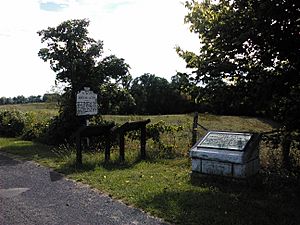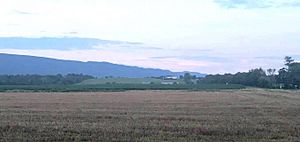Rude's Hill facts for kids
Rude's Hill is a 981-foot hill located near Mt. Jackson in Shenandoah County, Virginia, United States. This hill is famous because it was a very important spot during the American Civil War. Many battles and events happened here. The hill is named after Anders Rudolph Rude, a minister from Denmark who moved to the U.S. in 1836. He lived in a house on the hill called "Locust Grove," which was built in 1792.
Rude's Hill was a key location during the Civil War. It was a high point that looked over the important Valley Turnpike. This road passed between Smith Creek on one side and the North Fork of the Shenandoah River on the other. Rude's Hill was the first high ground after the flat Meems bottomland south of Mt. Jackson. It was easy to defend because enemies could only approach from the north by crossing bridges over Mill Creek and the Shenandoah River. After that, they would have to cross the wide, flat Meems Bottom, which Rude's Hill overlooked. Also, if soldiers needed to retreat, they could escape through mountain passes in the Massanutten Range. Because of its great location and the many battles fought there between 1862 and 1865, Rude's Hill played a big part in the Civil War history of the Shenandoah Valley.
Contents
Civil War Events at Rude's Hill
1862: Jackson's Headquarters
In the Shenandoah Valley campaign, Confederate General Stonewall Jackson moved his troops to Rude's Hill. This happened after a battle called the First Battle of Kernstown on March 23, 1862. Jackson used the "Locust Grove" house on the hill as his main base from April 2 to April 17, 1862. Here, he gathered his soldiers and reorganized his army, which grew to 6,000 men.
On April 16–17, 1862, there was a small fight at Rude's Hill. Union forces were getting closer. General Jackson had planned to stay and fight on Rude's Hill. However, his cavalry (horse soldiers) failed to destroy a key bridge at Mt. Jackson. So, Jackson moved his troops south on April 17. He later won many battles against Union generals in the Shenandoah Valley during May and June 1862.
The "Locust Grove" house was badly damaged during the war. Reverend Rude left in the fall of 1862. He became a minister and professor in Texas. But the hill kept his family name. General Jackson's messages from this base were dated "Rude’s Hill," and the name stuck. After 1862, Reverend Addison Weller and his wife lived in the house.
1863: Cavalry Skirmishes
From November 16–18, 1863, Union cavalry (horse soldiers) led by Colonel William H. Boyd explored the area. They had small fights in Woodstock, Edinburg, and Mt. Jackson. North of Mt. Jackson, they met Confederate cavalry. The Confederate soldiers moved back through Mt. Jackson, fighting as they went. They crossed bridges through Meems Bottom and reached the strong position on Rude's Hill.
Colonel Boyd saw that the Confederate cannons on the hill could easily hit the bridge. So, he pulled back from Rude's Hill and went to Woodstock. Confederate cavalry followed him. Boyd's scouting mission then returned to West Virginia. Not many soldiers were lost on either side during these small fights.
1864: Major Battles and Raids
Rude's Hill was very important during the Battle of New Market. On May 14, Confederate soldiers fought a delaying action at Rude's Hill. This slowed down the Union army. It gave Confederate General John C. Breckinridge time to gather his main forces about 4 miles away in New Market. Union forces eventually took the hill.
After losing the battle on May 15, Union General Franz Sigel set up a defensive line on Rude's Hill. His soldiers were tired and low on ammunition. So, Sigel decided to retreat across the Shenandoah River to Mount Jackson. General Breckinridge, worried the Union might try to hold Rude's Hill, moved his cavalry and cannons to the top of the hill. They fired at Sigel's retreating soldiers. The Union army managed to cross Mill Creek at Mt. Jackson and burned the bridge before the Confederates could catch them.
Later, on May 21, Major General David Hunter took over the Union command. He moved south and camped on Rude's Hill on May 29. Hunter then continued south, taking towns and destroying things that could help the Confederate army.
McNeill's Rangers Raid
On October 3, 1864, before dawn, Confederate Captain John McNeill led about 50 Confederate rangers. They attacked about 100 Union soldiers guarding a bridge at Meems Bottom. This bridge was a key crossing point on the Valley Turnpike. The attack lasted only 15 minutes, and most of the Union cavalry were captured. However, Captain McNeill, a well-known Confederate raider, was badly wounded.
He was taken to Reverend Weller's "Locust Grove" house on Rude's Hill. Union General Sheridan's troops later found out who he was. A small group of Confederates secretly moved McNeill away from Rude's Hill when the Union soldiers temporarily left, thinking he was too hurt to move. McNeill was taken to Harrisonburg, where he died on November 10.
Early's Retreat and Sheridan's Pursuit
In November 1864, Rude's Hill became a battlefield again. Union cavalry led by Philip Sheridan fought Confederate General Jubal Early. Sheridan had defeated Early in earlier battles. Sheridan then used "scorched earth" tactics, destroying farms and businesses in the Shenandoah Valley.
Early retreated about 33 miles to the strong position of Rude's Hill. He stayed there from October 21–31. Early later moved north but then fell back to Rude's Hill by November 12. Two of Sheridan's Union cavalry divisions followed Early. Early gathered his remaining Confederate soldiers on top of the hill on November 22, 1864. The Union cavalry attacked but were pushed back. Early then retreated from Rude's Hill to Harrisonburg. The "Locust Grove" house was looted by Union troops.
1865: End of the War and Reconstruction
Near the end of the war, Rude's Hill also saw a small cavalry fight. On March 7, 1865, Confederate Brigadier General Thomas L. Rosser's soldiers attacked Union troops who were guarding Confederate prisoners.
After the war ended, Union troops camped on Rude's Hill. They were the occupying force for the area. They built several buildings, including a hospital. This military post was removed in 1875 when the Reconstruction period ended.
In a sad local event during Reconstruction, Confederate Captain George Summers and Sergeant Isaac Newton Koontz were executed on Rude's Hill on June 27, 1865. They had been part of a Confederate group that disbanded after the war. They were on their way to take an oath of loyalty to the Union. Along the way, they had a conflict with Union guards and took their horses. The men went to the Union camp on Rude's Hill to explain and return the horses, and they were forgiven. But a month later, they were seized by a different Union commander, brought to Rude's Hill, and shot.
Rude's Hill Today
Today, historical markers on Rude's Hill show where these events happened. They are on the west side of Route 11, looking over the farmland of Meems Bottom. The hill was once a very important point on the Valley Pike. However, with today's fast-moving cars, it is hard for people driving by to notice its historical importance. An automotive repair shop now sits on the top of historic Rude's Hill.
|



